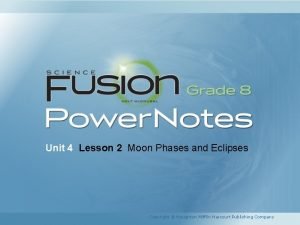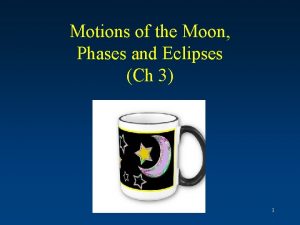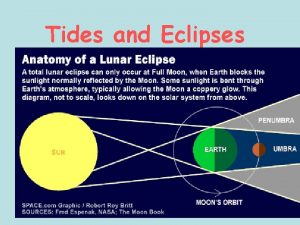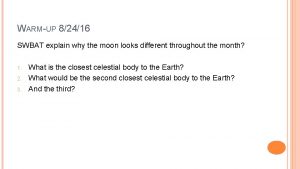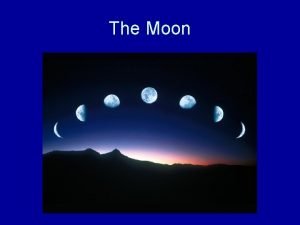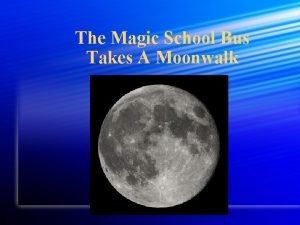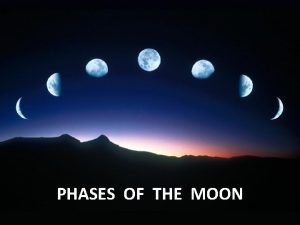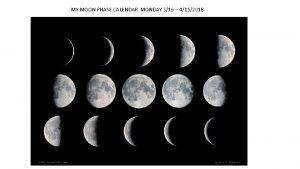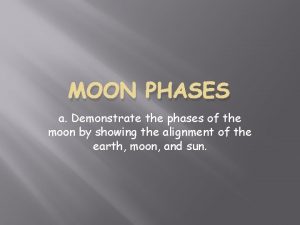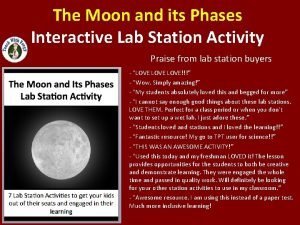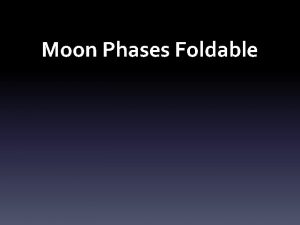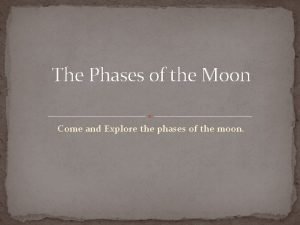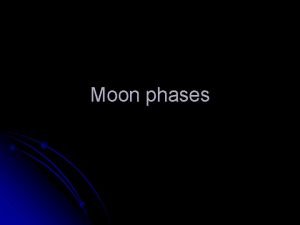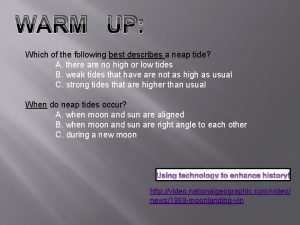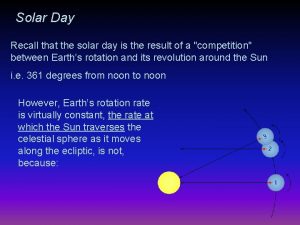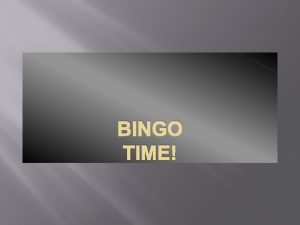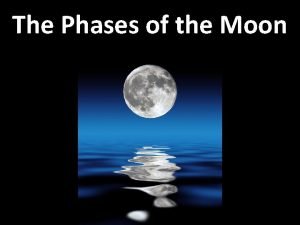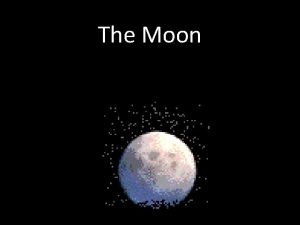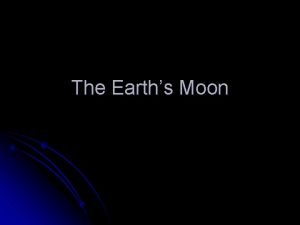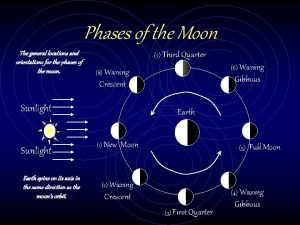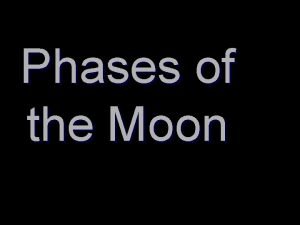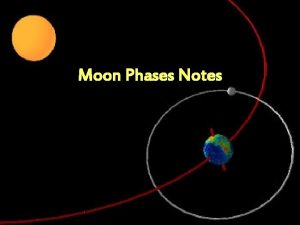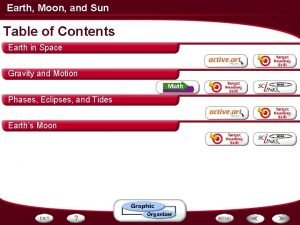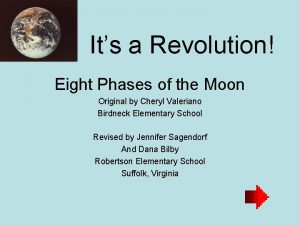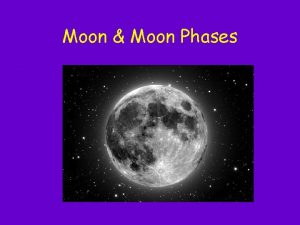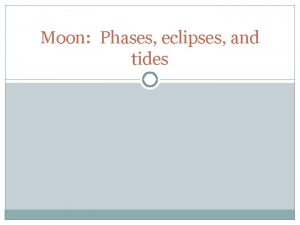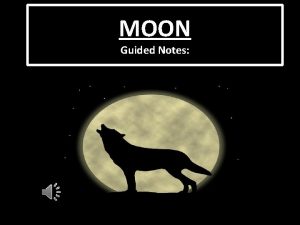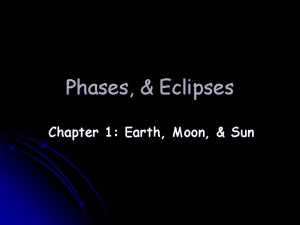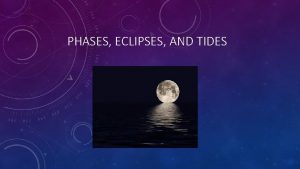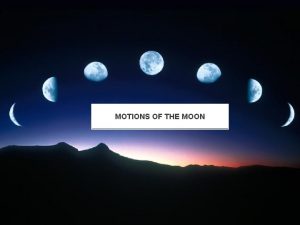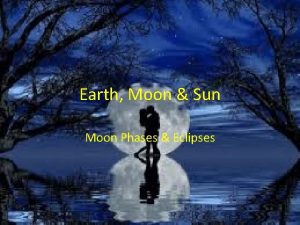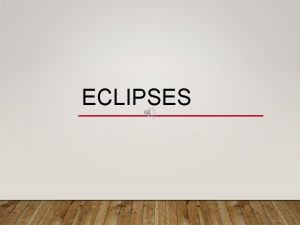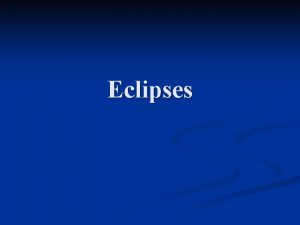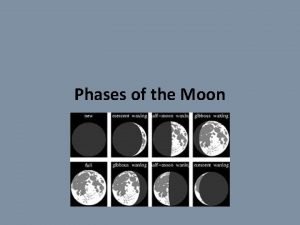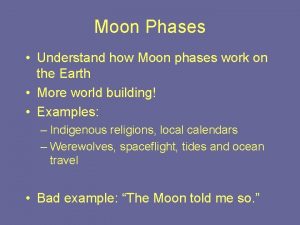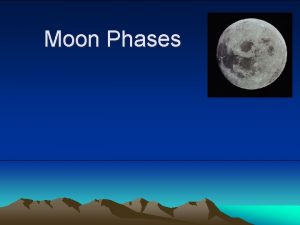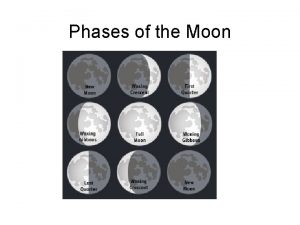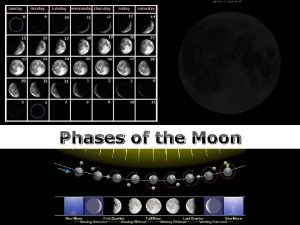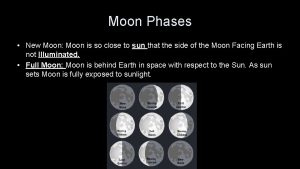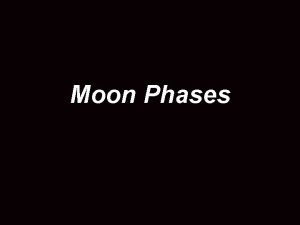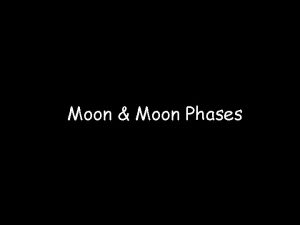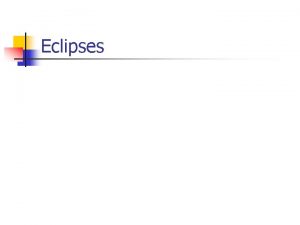Motions of the Moon Phases and Eclipses Ch



































- Slides: 35

Motions of the Moon, Phases and Eclipses (Ch 3) 1

Phases Eclipses 2

The Moon • The moon’s appearance changes significantly over the period of a "month" (to be carefully defined later) • Shines by reflected sunlight. What we see depends on geometry of the Earth. Moon-Sun system. • The different appearances of the Moon are called lunar phases. Around what time does a full moon rise? How far is a crescent moon from the Sun? 3

The Moon orbits the Earth as the Earth orbits the Sun. Half of the Moon is always illuminated, it’s just not necessarily the half we can see. This cycle of phases takes about 29 ½ days. 4

• "Waxing" means "increasing" • "Waning" means "decreasing" • "Gibbous" means "swollen" • Note: a first, or last quarter Moon appears half illuminated, not ¼ illuminated. The "quarter" refers to how far along in the cycle of phases it is. • Historical note: the curved shape of lunar phases indicated to Pythagoras (c. 500 B. C. ) that the Moon must be a sphere! 5

Moonrise and Moonset (full Moon) Times of rising and setting depend on the Earth-Sun-Moon configuration as viewed from the surface of the rotating Earth Moonset Sunrise Midnight Noon Moonrise Sunset ・Full Moon rises as the Sun sets. ・It’s overhead at midnight. ・It sets as the Sun rises. ・It cannot be seen during the day. Moon phases simulator 1 Moon phase simulator 2 6

Notice the lunar features in common at different phases: we always see the same side of the moon, but different fractions are sunlit during cycle of phases: 7

The Moon spins in exactly the same time it makes one orbit around the Earth. Rotation and revolution are synchronous. This is very common behavior in the Solar System, called "synchronous rotation", or "tidal locking". Return to this when we study tidal force. 8

The "Month" There actually three kinds of "month": 1. The sidereal month is the length of time it takes the Moon to orbit the Earth with respect to the background stars. It is about 27. 32 days. 9

2. The synodic month, or lunar month is the time it takes the Moon to complete one cycle of phases, about 29. 53 days. Note this is longer than a sidereal month. 3. The months we use: varying lengths, averaging longer than sidereal or synodic month. 10

Solar eclipses A solar eclipse is seen if the Earth is passing through the shadow of the Moon. The whole Earth does not fit in the shadow of the Moon. 11

Lunar eclipses A lunar eclipse is seen if the Moon is passing through the shadow of the Earth. 12

Why don't we see an eclipse with every new and full Moon? => Because the plane of the Moon’s orbit around the Earth is not exactly in the plane of the Earth’s orbit around the Sun. 13

Plane of Moon’s orbit is tilted about 5° to ecliptic. Intersection of the two planes is the "line of nodes". 14

Only when the Sun and Moon are on the “line of nodes” defined by Earth’s and Moon’s orbit is an eclipse possible. Put another way, the Moon must be in the same plane as the Sun, the ecliptic. Hence certain seasons are favorable for eclipses. Solar “eclipse season” lasts about 38 days. Likely to get at least 15 a partial eclipse somewhere.

It's worse than this! The plane of the Moon's orbit precesses, so eclipse season occurs about 20 days earlier each year. Saros cycle: 18 years, 11 days. Earth-Moon-Sun return to same configuration, eclipses return to original times of year. 16

Types of lunar eclipses • Lunar eclipses can be total, partial, or penumbral, depending on the Earth – Moon – Sun geometry. • An object’s shadow has two parts: • The umbra is the darkest part, where the Sun is completely blocked. • The penumbra is not as dark, since some of the Sun’s light gets by. 17

Umbra and Penumbra • Umbra: the disc of the Sun is completely blocked. • Penumbra: the disc of the Sun is only partially blocked. Some light still reaches all of Moon’s surface. 18

Earth’s umbra due to Sun extends well beyond Moon’s 19 orbit.

Path 1 produces a penumbral lunar eclipse. Path 2 produces a total lunar eclipse. Path 3 produces a partial lunar eclipse. Question: will lunar eclipses be visible in daytime or nighttime? 20

Photos taken during the course of a total lunar eclipse: Note reddish color during totality – some light bent in Earth’s atmosphere and reaches Moon. Why red? Because shorter wavelength light is scattered out of path. This is same physics that produces red sunsets – more later. 21

Types of solar eclipses • Solar eclipses can be total, partial, or annular, depending on geometry. • Angular diameter of Moon is about 1/2° angular diameter of Sun can block the Sun’s disk from view. = 22

• However, the angular size of the Moon varies because Earth-Moon distance varies (orbit not perfect circle, varies about 5%). 23

The Moon’s shadow also consists of an umbra and penumbra. Observer inside the Moon's umbra: total solar eclipse Observer inside the Moon's penumbra: partial solar eclipse 24

When eclipse occurs when moon is relatively far from Earth, umbra does not reach Earth’s surface. Eclipse not total but annular. 25

The penumbra is not uniformly dark • Gradually gets brighter going outwards • That's because you see more and more of the Sun 26

Photos taken 5 -min apart during a total solar eclipse. 27

Total Solar eclipses • Localized and short: – Moon's umbra 267 km across at most – Lasts at most 7. 5 min, with a fast sweeping shadow west to east Next total eclipse visible close to here: Not until 2017! (Partial here, total further north). Annular one in 2012, another in 2023. 28

Total and annular eclipse paths, 2000 - 2020 29

30

Which one occurs most often, solar or lunar eclipses? • Solar eclipses: 2 -5/year (but cover a very small area). • Lunar eclipses: also 2 -5/year (but covers the whole angular size of the Earth). Can be seen from entire nighttime side of Earth. 31

For how long will we be able to see total solar eclipses? • Because of tidal friction, the orbit of the Moon is growing larger by about 3. 8 cm/yr. • At the current rate, the Moon will be too far away in about 600 million years. 32

33

Centered at 1: 17 am here 34

35
 Lesson 2 moon phases and eclipses answer key
Lesson 2 moon phases and eclipses answer key Which best explains why the moon has phases?
Which best explains why the moon has phases? Lunar eclipse moon phase
Lunar eclipse moon phase Tides and eclipses
Tides and eclipses The sun-earth-moon system worksheet answers lesson 1
The sun-earth-moon system worksheet answers lesson 1 Eclipses and tides lesson 3
Eclipses and tides lesson 3 Moon phases of the sun is on the right
Moon phases of the sun is on the right A person standing in the moon's penumbra will see a
A person standing in the moon's penumbra will see a Magic school bus sun and moon
Magic school bus sun and moon What is the moon phase tonight
What is the moon phase tonight Hawaiian moon phases
Hawaiian moon phases What causes the phases of the moon
What causes the phases of the moon What causes the phases of the moon
What causes the phases of the moon Moon phases when the sun is on the left
Moon phases when the sun is on the left Moon phases interactive notebook
Moon phases interactive notebook Moon phases foldable
Moon phases foldable Moon phases foldable
Moon phases foldable Whats the first phase of the moon
Whats the first phase of the moon Moon phases
Moon phases Which earth
Which earth Which phrase describes neap tides?
Which phrase describes neap tides? Moon phases
Moon phases Phases of the moon animation
Phases of the moon animation Moon phases bingo
Moon phases bingo During ____ phases more of the moon is visible each night
During ____ phases more of the moon is visible each night New moon
New moon Moon phases characteristics
Moon phases characteristics Moon phases
Moon phases Phases of the moon
Phases of the moon What do the phases of the moon depend on
What do the phases of the moon depend on Lunar movement
Lunar movement Define third quarter moon
Define third quarter moon The phases of moon occur mainly due to
The phases of moon occur mainly due to Eight phases of the moon
Eight phases of the moon Duo servicekantoor
Duo servicekantoor Which moon phase occurs directly before a new moon
Which moon phase occurs directly before a new moon
